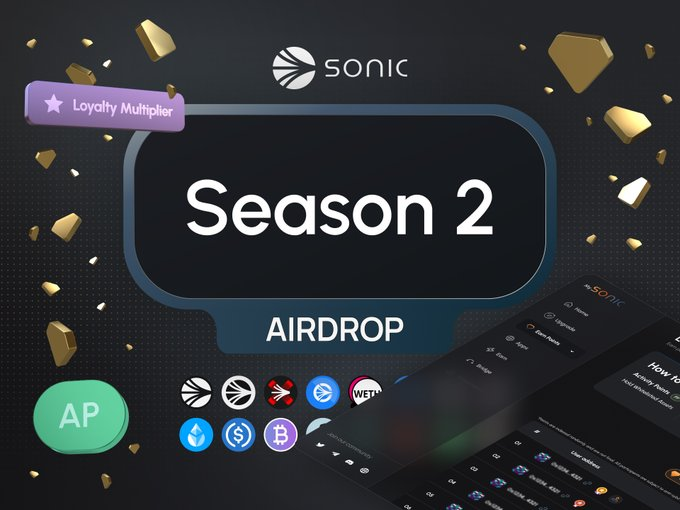Sonic Season 2 Airdrop: Restructuring On-Chain Value Distribution Logic
On June 10, 2025, Solana ecosystem Layer2 network Sonic announced the launch of its second season $S token airdrop, starting on June 18. This round totals 150 million $S tokens (15% of the total supply), a 25% increase from Season 1, with a revolutionary distribution mechanism:
-
User Side (70%): Replacing simple transaction count, users earn based on four dimensions of behavior scoring — Gas consumption (20%), LP depth contribution (30%), cross-chain asset volume (25%), and task diversity (25%);
-
Developer Side (30%): For the first time, a composite scoring model is introduced based on protocol revenue (50%), user growth (30%), and bug bounties (20%).
This upgrade marks a qualitative leap from airdrop as a marketing tool to a true engine of ecosystem growth, targeting an increase in genuine user share to 92%, addressing the 22.3% Sybil attack rate of Season 1.

This market insight article explores how Sonic Season 2’s on-chain behavior scoring and developer-revenue binding models bring transformative value to ecosystem building.
Mechanism Innovation: Paradigm Shift from Transaction Volume to Value Creation
User Behavior Scoring System
Sonic has built a multi-dimensional framework for evaluating on-chain behavior:
-
Gas Consumption (20%) incentivizes real demand: each 1 Gas spent earns 10 points, preventing zero-cost wash trading;
-
LP Depth Contribution (30%): $1,000 liquidity held for 30 days earns 15 points — three times more weight than short-term deposits;
-
Cross-Chain Asset Volume (25%): Transferring $1,000 from Ethereum/Solana earns 25 points;
-
Task Diversity (25%): Completing DeFi, GameFi, and NFT tasks earns a 1.2x multiplier on base scores.
Anti-Cheat System Upgraded
-
Behavioral fingerprinting: Links device IDs (e.g., accounts under same IP are downgraded);
-
Temporal pattern recognition: Bot-like repetitive behavior is penalized;
-
Fund traceability: Deposits from exchange cold wallets do not earn points.
These upgrades raised Sybil detection from 48% to 92%.
Developer Revenue Binding Mechanism
Sonic pioneers directly linking airdrops with protocol income:
-
Developer Score = (Protocol Revenue × 0.5) + (New Users × 0.3) + (Bug Fixes × 0.2)
-
Protocol Revenue = ∑ (User Gas Fees × 15% share) + Fees
For example, testnet DEX SonicSwap generated $1.2M in 30 days ($800k from Gas share, $400k in fees), added 37,000 new users, fixed 5 high-risk bugs, scoring 84.5/100.
This model resembles the Apple Store profit-sharing structure, encouraging developers to focus on true value creation over airdrop farming. Scoring calculator available via JuCoin’s simulator.
Ecosystem Impact: Data Growth & Competitive Realignment
Sonic Ecosystem Overview
-
TVL: $530M (7th among Layer2s), projected to surpass $800M after airdrop;
-
Active DApps: 127 (including SonicSwap and Sonic Runners);
-
Monthly Active Users: 890k, aiming for 1.5M during airdrop season.
Layer2 Airdrop Strategy Comparison
Compared to zkSync’s cross-chain bridge usage metric (Sybil rate 4.7%) and Starknet’s NFT minting model (22.3%), Sonic’s value-creation approach shows three strengths:
-
Anti-Sybil Resilience: Multidimensional behavior makes cheating 300% more costly;
-
Developer Retention: 41% of Season 1 winners kept building; revenue binding may raise this to 70%;
-
Economic Sustainability: Protocol revenue recycles back into the ecosystem, creating a growth flywheel.
Risk Warnings: Game Theory and Regulatory Challenges
Economic Model Stress
-
Token Sell Pressure: Circulating supply rises from 27% to 42%, daily sell-off may reach $2.9M;
-
Gas War Risk: Simulations show wash trading could drive fees to $0.85 per transaction;
-
Fake Revenue: Developers may fake revenue via wash trades (on-chain AML needed).
Regulatory Sensitivities
-
Securities Debate: U.S. SEC may consider revenue sharing as unregistered securities (see Coinbase lawsuit);
-
Tax Compliance: Cross-border users must comply with varying rates (e.g., U.S. 30% capital gains tax).
Industry Significance: Paradigm Shift in Airdrop Design
If Sonic Season 2 achieves the following, it could set a new industry benchmark:
-
User Growth: Reach 1.5M MAUs (currently 890k);
-
Developer Retention: >70% of Season 1 winners continue development;
-
TVL Surge: Hit $800M in 90 days, absorbing 60% of token sell pressure.
Success could transform airdrops from mere giveaways to ecosystem engines, pushing rivals like zkSync to revise their incentive models. Failure (e.g., Sybil rate >15%) could trigger a token confidence crisis and TVL exodus.





